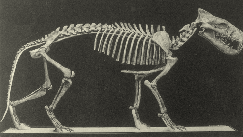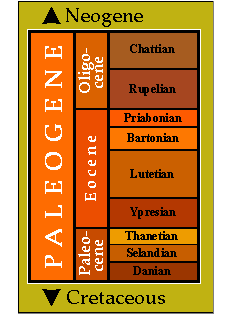
Hyaenodon horridus, a large carnivorous mammal from the White River Oligocene of South Dakota. Deposits containing Hyaenodon are found in Badlands National Park.
| The Oligocene epoch is part of the Tertiary Period in the Cenozoic Era, and lasted from about 33.7 to 23.8 million years ago (mya). The Oligocene is thus a relatively short span of time, though a number of major changes occurred during this time. These include the appearance of the first elephants with trunks, early horses, and the appearance of many grasses -- plants that would produce vast tracts of grasslands in the following epoch, the Miocene. |

|
|
Hyaenodon horridus, a large carnivorous mammal from the White River Oligocene of South Dakota. Deposits containing Hyaenodon are found in Badlands National Park. |
 |
Oligocene: The chart at left shows the major subdivisions of the Paleogene, the first portion of the Tertiary Period, including the Oligocene. You may click anywhere on the other Epochs or on the arrows to navigate to those exhibits. The Oligocene Epoch is part of the Cenozoic Era. |
Find out more about the Tertiary paleontology and geology of North America at the Paleontology Portal.


